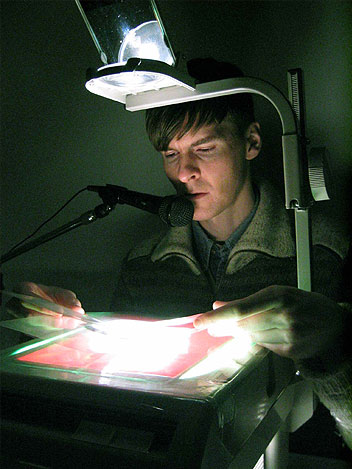Every Time I See Your Picture I Cry: and wish you hadn't included the serial killer

Toronto: I didn’t read the program notes before seeing Every Time I See Your Picture I Cry by Daniel Barrow (and part of this year’s SummerWorks Festival). So my initial impressions were quite far off base.
Although Barrow never appears – he remains a disembodied voice coming through the speakers – the show has the confessional, first-person feel of a one-person show. At first, I took this at face value and was immediately reminded of Barry Smith, who also uses audio-visual presentations in his work. Where Smith is front and centre, Barrow remains hidden allowing the screen with its overhead projections to dominate the theatre space. There is a rush of excitement at seeing Barrow’s low tech manipulations lit through an overhead projector; he calls them manual animation and this is a perfect description. The illustrations frequently have elements that come to life beautifully and a 19th century lantern show aesthetic is evoked, further enhanced by the sound of the slides being changed.
The protagonist of Every Time has trouble with his eyesight and Barrow makes fascinating (and surprisingly fresh) references to Helen Keller which has inspired me to go and search out more about her (googling Keller is actually a joke in the show). As the show progresses and the narrative becomes more bizarre it dawned on me that the show wasn’t autobiographical at all. At this point I was reminded of Tim Crouch from the UK, in particular his show My Arm – which also starts off feeling like a “true story” only for it to become progressively clear that the story couldn’t possibly be true. Where Crouch kept a tight rein on his material and operated within a defined reality – and used that material to provide some wonderful insights – I’m afraid Barrow doesn’t reach the same heights.
The story is about a garbage man who wants to create his own, special phone book, which includes an illustration of each person (which he traces through their windows while they sleep) and fragments of information about them (which he gathers by sifting through their garbage). This is a wonderful, rich concept – especially given the method of Barrow’s hidden delivery and the found quality of so many of the illustrations. Unfortunately none of this is particularly clear – unless, of course, you read the program notes before going in. Even less clear is that the garbage man is being tracked by a serial killer (!) who kills each of the phone book subjects in turn. Instead of turning the work into some sort of Manitoba Gothic, it simply put me in mind of Silence of the Lambs or Se7en. I half expected Morgan Freeman to appear and intone wisely about the nature of evil.
This is a very personal response, granted, but I can think of fewer things less interesting (or more explored in popular culture) than serial killers and I have no idea why Barrow included this element. In an interview on the SummerWorks site, he claims that the Bag Lady makes the Garbage Man’s work obsolete. The garbage man is therefore a failed artist “in the grip of something overwhelming”. I would argue that an artist who has failed through his own foibles, weaknesses or common misfortunes would be far more compelling subject than one being chased around by a homicidal maniac.
I think this links to another problem: there are simply too many ideas. The concept of a near-blind garbage man creating secret work and over-identifying with Helen Keller is more than enough for an hour long work but Barrow keeps giving us more and more information about the garbage man: his background, his thoughts and ideas. Most of these are interesting in their own right but they float free of the narrative and I started to get more and more lost as to where to situate myself in relation to the work.
Still, I would recommend that people check out Barrow’s work. It is unique and the images are at turn beautiful, haunting and disturbing. It is like watching a children’s storybook turned inside out and placed onto a light-box. Barrow is clearly a smart guy and he just needs to focus that intelligence more surgically. And leave the serial killers to Hollywood. He’s too good for that shit.



